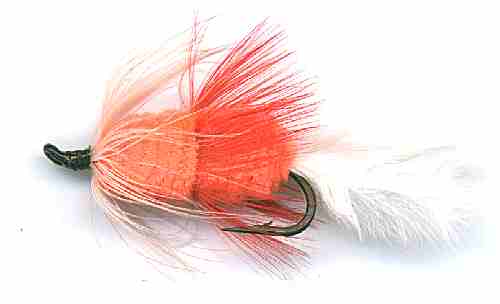The Babine Special Single Hook Fly
This classic steelhead salmon egg pattern was originally used on the Babine River. It is meant to resembles drifting roe from spawning fish. The white wing mimics milt (sperm) that has covered the eggs. Weight the hook so the fly will travel near the bottom.

TROUT AND STEELHEAD SINGLE HOOK FLY PATTERNS. Hook size 6 - $US each
If you see spawning fish, cast the fly so it will sink to the bottom downstream from the happy couple. When salmon spawn in the fall (Autumn), there are always steelhead and trout just downstream from them, waiting to scarf up loose eggs, waiting to make a meal of the drifting roe.. It should be fished dead drift near the bottom during spawning seasons. If you see spawning salmon, cast so the fly lands just behind them and drifts down stream from the spawning pair. You can bet this is where the steelhead or trout are waiting for those drifting eggs.. Many fly anglers won't use an egg fly because it looks too much like bait. I think that is a silly reason not to use a fly. Egg flies imitate a naturally-occurring food that wild trout, steelhead, and salmon eat with gusto.
The Babine Lake in Canada is British Columbia's largest Natural Lake. The water flows eventually into the Pacific Ocean at Prince Rupert after a 600km journey. The Babine River below Nilkitka Lake is justifiably world famous for its fabulous steelhead fishing in the fall. The stretch between Nilkitka lake and the Babine Lake is just as well known in Canada for its large, feisty trout to which it owes its name - Rainbow Alley. Like many other rivers in this area with lakes at their head, the Babine is clear, gravel bottomed and has prolific hatches of stoneflies, caddis and mayfly. but the real key to the abundance of large trout is the presence of thousands of spawning chinook, coho and sockeye salmon each summer. The oil rich salmon eggs fatten up the trout for the winter and in the spring, the eggs which survived turn into millions of tiny alevin. They stay in the gravel and survive off their yolk sacks until the water warms around mid May. They fry then struggle free to begin their journey to the lakes where they will live and grow for two years before migrating to the sea. Not all of them live that long as they too become food for trout and steelhead.
To some fishermen using egg patterns is not true fly fishing. Everyone is entitled to their own opinion. I believe that if you are imitating the natural food of your target fish then this is fly fishing. The art of matching the color and size of eggs that are being eaten is an art form just like matching the hatch of emerging dry flies. Not all salmon eggs are the same. Spawning King and Chums have much larger eggs than sockeye's. You can find that the hungry trout have discerning tastes. They are only targeting eggs of a certain color and size. Eggs that are laid by one particular salmon species and leave the others. It is therefore important to understand the color differences and what is the favorite color and size of the eggs eaten by your target trout or steelhead. Most eggs are a very bright orange when first laid. They gradually change shade. They take on a milky white tint as they develop or decompose.

